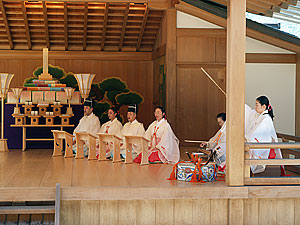
By Bill Roberts
Bill Roberts, a writer who is spending a year at Oomoto, delivered the following speech to the Tottori branch following its monthly service on Dec. 12, 2004.
Konnichiwa. Bill Roberts des. Yoroshiku.
Thank you for asking me to speak today. I have been to Japan several times but this is my first visit to Tottori. This is a very pretty place. I especially enjoyed visiting the Tottori sand dunes, the village of Iwai and Yoshioka onsen.
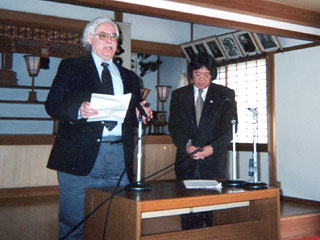
I would also like to say a few words about today’s service. I have seen many tsukinamisai (monthly service) in Kameoka, Ayabe and various Oomoto branches. Today’s was special for a couple of reasons. It was interesting to see young people and a woman serving together as priests. And when we were chanting the prayers your voices created an especially beautiful harmony.
The timing of my visit here is appropriate given the purpose of my stay in Japan and given where the world, especially my own country, seems to be at this point in history.
I am here for one year to write a book about Oomoto. I will tell you more about this project in a few minutes. For now, let’s just say that any book about Oomoto must include Onisaburo Deguchi as one of its main characters. And how can anyone write about Onisaburo without mentioning his Yoshioka prophecy or visiting the site?
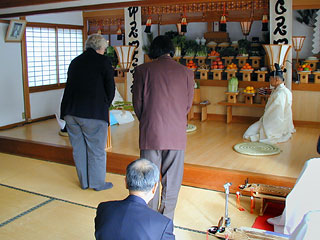
Bill Roberts makes the pine branch
offering at the monthly service.
He gave this prophecy exactly 59 years ago this month. The Second World War had just ended disastrously for Japan, and Onisaburo had recently been cleared of all criminal charges in the Second Incident. In the aftermath of war and incarceration, Onisaburo made what was to be his last public speech here in Tottori.
In the Yoshioka prophecy, he recalled that he had predicted Japan’s devastation many times and then declared: “The country [Japan] is now totally disarmed, but this situation holds a noble mission for Japan as pioneer of world peace. True world peace will only come about when the whole world is disarmed.”
World peace, disarmament and the folly of war were persistent themes in Onisaburo’s life-long spiritual mission. And they are as pertinent in today’s world as they were six decades ago. This is another reason the timing of my visit to Tottori is appropriate. For today my own country has become belligerent and a threat to world peace.
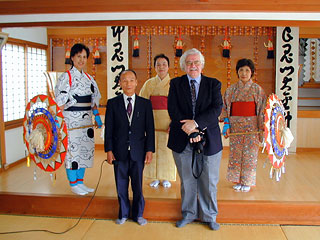
Bill Roberts with a dance team that performed
a traditional rain dance after the monthly service.
I see some disturbing parallels between America today and Japan of Onisaburo’s time. For example, in the Yoshioka declaration, Onisaburo stated that Shinto had been misused for political goals. In America, certain politicians, including the current president, use their Christian faith to justify domestic policies that are really driven by greed, and foreign policies that are actually driven by fear and vengeance.
We already see the disastrous results of these policies: A widening gap between rich and poor, a shrinking middle class, the declining environment and --at the top of the list-- the continuing death and destruction in Iraq.
Here’s another parallel between Japan then and America now. Just as Onisaburo and many Japanese opposed imperial policies, many Americans oppose current U.S. policies. Nearly half of the voters in our recent presidential election, including me, voiced their disapproval of these policies by voting for the other candidate.
I fear that America, like imperial Japan, may have to pay a steep price for its arrogance and aggression. I do not know how or when. Unlike Onisaburo I am not a prophet.
I hope I have not offended anyone by talking about politics. My intention is to illustrate how relevant Onisaburo’s words at Yoshioka are in today’s world.
The broader message he offered at Yoshioka, and throughout his life, was a message of peace, love and hope. His commitment to art and interfaith efforts—these were just some of the ways to help achieve peace, love and hope. It is impossible to make war and make art at the same time.
This brings me to the book I am writing.
Thirty years ago Frederick Franck, an author, artist and physician, wrote “An Encounter With Oomoto.” This fine, slender volume was the last book written in English about Oomoto. It is still in print but much has happened in 30 years and some people at Oomoto, including the Spiritual Leader, think it is time for someone to take a fresh look.
So, the Oomoto Foundation commissioned me to write a book in English to explain Oomoto to a non-Japanese audience, especially the artists and interfaith activists who are attracted to Oomoto for somewhat different reasons.
Many artists in the West are intrigued when they first hear about a Shinto sect that uses the arts as part of its spiritual practice. And they are eager to learn more when they hear about the multi-talented Onisaburo Deguchi who preached that the value of art is the process of doing it, not the final product.
Onisaburo also wrote: “Art is not the preserve of the specialist, but a Way for every ordinary human being to himself and to God.” These words ring true for increasingly more artists from the West.
The Oomoto teaching that attracts another audience is the belief that all gods are one god and all religions come from the same great origin. The implication of this teaching is the need for religious tolerance, which is in short supply just now. But there are many ecumenically minded people in all religions attracted to Oomoto’s interfaith activities.
Most non-Japanese first encounter Oomoto either through the arts or through interfaith activities. These people are the primary audience for this new book.
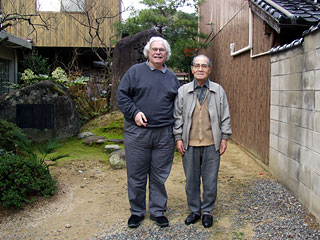
Bill Roberts and Masateru Tanaka, whose father
knew Onisaburo Deguchi. The Yoshioka Declaration is
on the rock behind them to the left.
Personally, I first encountered Oomoto through the arts, specifically Onisaburo Deguchi’s tea bowls. I earn my living as a freelance journalist in Silicon Valley, California, where I write about technology and business for various magazines. In 1998 I began to study ceramics as a hobby with Coeleen Kiebert, an artist and teacher in my part of California. Coeleen attended Oomoto’s traditional Japanese arts seminar in 1985.
One day Coeleen said she would take a group of students to Oomoto to study the Japanese arts in the spring of 1999. She talked about Onisaburo Deguchi and showed us pictures of his tea bowls. I was captivated by the spirit of Onisaburo’s yowan. I signed up for the trip and by the end of that visit I was enthralled with Japan, especially its scenery, culture and arts. I was also touched by Oomoto’s friendliness and hospitality.
After that first trip I was surprised at how much I liked Japan. In retrospect I should not have been surprised at all. You see, my parents met in Japan after World War II. My father was a career Army officer and my mother was a civilian secretary for the Army. They were married in Tokyo in 1947.
I was conceived in Japan in April 1949 about three months before my parents returned to the United States, where I was born. So my first trip to Japan was exactly 50 years after I was conceived here, which makes Japan a special place for me. But I had to come here that first time to understand this and to feel it in my heart.
I returned to Japan with Coeleen in the spring of 2000 and in the spring of 2001. Because of my growing interest in Oomoto and my writing skills, the Oomoto International Department then invited me to work on several editorial projects.
I first came as a volunteer for three months in late 2001. I returned for several weeks in 2002 for the Second Prayer Offering and World Religious Forum. And I came in the summer of 2003 for the visit to Ayabe by Israeli and Palestinian teenagers. Most of the stories I wrote and the photos I took during these visits were for the English section of the Oomoto home page.
On this current trip, I arrived in October and I plan to stay about a year to write this book. I did quite a bit of research on my previous visits but I have many more interviews to conduct with Oomoto followers. In Tottori, for example, I interviewed Taga Noriyuki, the chief of the Tottori branch, and Masateru Tanaka and Kunimaru Kakehi, whose fathers knew Onisaburo. I also met and had interesting conversations with the Youth Division and the Women’s Group.
I believe Oomoto offers an important message to artists, religious people and peace seekers everywhere. Oomoto is clearly one of the pioneers for world peace that Onisaburo noted in his Yoshioka prophecy.
My own ceramics teacher, Coeleen Kiebert, made the following observation after her last visit to Oomoto just a few weeks ago: “When people ask me about this trip, I tell them you don’t have to worry about peace. There is a grand, concerted effort being made by the people of Oomoto and Japan. The path to peace is in the arts not war, which will be its own undoing.”
I believe Oomoto is a beacon in a darkening world, offering a message people everywhere desperately need to hear during these dangerous times. I hope the book I am writing will in some small way help to convey this message to people outside Japan.
Kyo-wa watashino hanashi-o. O-kiki kudasari. Arrigato gozaimashta.
New Contents Thu, May 20, 2010
- Oomoto participates in Sant’Egidio conference : Dialogue among religions and cultures : On divided island nation of Cyprus By Bill Roberts
- Photo Album : Portraits of three branches: Shoko, Tanegashima and Aomori By Bill Roberts
- Oomoto FAQ
- A Letter from Oomoto : Of mountains and myths By Bill Roberts
- Polyglot poem festival The Utamasturi is going international — what’s next? By Bill Roberts
- Ethics education program captures the spirit of Bankyo Dokon By Bill Roberts
- A Letter from Oomoto : A year’s worth of adventure in a summer of branch visits By Bill Roberts
- In Kumamoto, it’s all about water – and fire By Bill Roberts
- A speech by Nevada Taylor at the Kii Branch in Wakayama Prefecture on April 13, 2008.:An Encounter With Oomoto Through Aikido
- Utamatsuri, Poem Festival, in Tokyo(on April 17, 2008)
- A speech by Neil Ryan Walsh at the Kobe branch on Mar. 9th, 2008.:Planting the Seeds of the Soul
- Meeting with the Fifth Spiritual Leader of Oomoto, Madame Kurenai Deguchi by Neil Ryan Walsh
- A speech by Neil Ryan Walsh at the Nagoya branch on Feb. 17th, 2008.:The Japanese Arts beyond National Boundaries
- To the Oomoto branch in Nagoya: City of Eel and Toyota by Neil Ryan Walsh
- A Speech by Nissim Ben Shitrit, Ambassador of Israel on the occasion of the Oomoto Setsubun Grand Festival in Ayabe February 3rd, 2008 : Japan and Israel : Two Lands Balancing the Needs of Traditional Culture and Modern Life. r
- A permanent memorial to Onisaburo (A Speech at the Autumn Grand Festival , November 6, 2007 : )By James Parks Morton, Founder and Chair, Emeritus of The Interfaith Center of New York
- Israel, Palestine and the Power of Poetry(Oomoto believes small efforts can have lasting ripple effects on people and peace)By Bill Roberts
- “Something Great”(This genetics pioneer, a friend of Oomoto, offers a clue to the mystery of life)By Bill Roberts
- Kamishima Cleanup (Harima branch members regularly visit this sacred island to keep the shrine tidy)By Bill Roberts
- Kyotaro Deguchi was one of six recipients of the 2007 James Parks Morton Interfaith Award
What is Oomoto?
- What is Oomoto?
- Spirtual Centers
- Founders and Spiritual Leaders
- History
- Organization and activities
- Teachings and scriptures
- Art Works of Founders and Leaders
Opinions[Archive]
- Statement of regret for the outbreak of war against Iraq (March 20,2003)
- Jinrui Aizenkai dispatched the "Urgent Appeal for a World (Global) Crisis" on March 14.
Grappling with Bioethics[Archive]
- Oomoto’s support for abolishing the death penalty (12, June 2003)
- The Oomoto Foundation protests any birth of a human clone baby. (5, January 2003)
- OOMOTO'S VIEW REGARDING JAPAN’S PERMITION TO THE RESERCH OF HUMAN EMBRYONIC STEM CELLS (ES cells)(12, June 2000)
Vistor’s Review[Archive]
- A speech by Bill Roberts at the Oomoto branch in Hiroshima after its monthly service on March 18, 2007:Encounters with war and peace
- How Bankyo Dokon changed one life by Linda Macphee
- A speech by Bill Roberts at the Hokuriku (Kanazawa) branch on Dec. 3, 2006:Ritual and myth -an encounter with ‘divine madness’
- A speech by Bill Roberts at the Himeji Cultural Center on Feb. 25, 2007:Mesmerized by the Japanese Arts
- A speech by Bill Roberts at the Kobe branch on Feb. 11th, 2007.:There are just human tears and human joy
- A Speech on the occasion of the Oomoto Setsubun Grand Festival in Ayabe February 3rd, 2007 : Egypt's role in Middle East peace
- Keynote Speech for the 28th World Federation Japanese Religionists Conference for World Peace in Tokyo (at Kokugakuin University, Novermber 29, 2006):Vision for Peace in the Middle East By Dr. Munther S. Dajani, Professor Dean, Faculty of Arts, Al Quds University, Jerusalem
- A speech to the Kyoto branch:Spiritual adventures in researching Oomoto leaders
- A Speech at The Oomoto Foundation on Monday, November 6, 2006 : Jordan's role in Middle East By Samir Nouri, Ambassador of the Hashemite Kingdom of Jordan
- A letter from Oomoto:The Young People of Tottori
- A speech by Bill Roberts on the occasion of the dedication ceremony for the new shrine of Tottori Branch By Bill Roberts Oct. 8, 2006
- A speech by Bill Roberts at the Oomoto branch in Hiroshima after its monthly service on March 18, 2007:Encounters with war and peace
- How Bankyo Dokon changed one life by Linda Macphee
- A speech at Setsubun : A Portrait of Oomoto By Bill Roberts Feb. 3, 2006
- New Publication ! By Bill Roberts Feb. 3, 2006 A Portrait of Oomoto
you can read this book in html => http://www.jinruiaizenkai.jp/English/en-kolumno/en-bill/en-sugao/billbook1en.html
E-mail below to order brobert1@ix.netcom.com
Current Topics
- Prayer Offering and World Religious Forum II
- Living the art of dialogue
- Kyotaro Deguchi was one of six recipients of the 2007 James Parks Morton Interfaith Award
Books
Online Books
- Divine Signposts by Onisaburo DEGUCHI
- The Creation of Meaning by Hidemaru Deguchi
- Bankyo Dokon(Seventy years of Inter-Religious Activity at Oomoto)
- Nao Deguchi — A Biography of the Foundress of Oomoto
- The Great Onisaburo Deguchi published by Aiki News
- Bankyo Dokon Seventy Years of Inter-Religious Activity at Oomoto
- Insearch of Meaning
- Nao Deguchi A Biography of the Foundress of Oomoto
- A Portrait of Oomoto By Bill Roberts
Oomoto international Archive
- The History of Oomoto (Jan.– Mar. 1980 — Apr.– Jun. 1982)
- The Ancestors; Friends or Foes? (Apr.– Jun. 1987)
- Tsukinamisai; The Sabbath of Shinto (Jan.– Jun. 1983)
- The Poem Festival at Oomoto; An Ancient Rite Lives Again (Oct.– Dec. 1981)
- Purification of the Universe ; Oomoto's Setsubun Festival (Apr.– Jun. 1981)
Links
Flowers at Ten'on-kyo & Baisho-en (photographs)
Contact
All rights reserved : the Oomoto Foundation Produced by the Netinformational Commission
Since : Mar. 7.1998 Last Update : Thu, May 20, 2010
E-mail : webmaster@oomoto.or.jp
Top Page Nihongo Esperanto Português Roomazi



